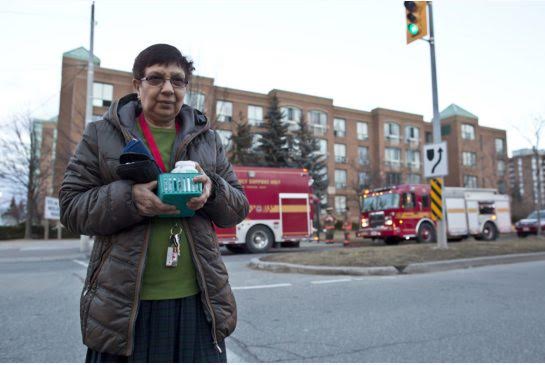The Case for Piercing TCHC’s Corporate Veil

On 5 February 2016, a fire in a Scarborough residence run by Toronto Community Housing Corporation (TCHC) claimed the lives of three seniors and injured several others, including twelve people who had to be hospitalized. The Toronto Fire Marshal announced that it would be filing non-criminal charges under section 2.4(2) of the Ontario Fire Code against the TCHC for placing combustible materials near a fire exit. The following is an articulation of why those charges should be left at the doorstep of the individual officers of the TCHC, and not the corporation itself.
Those who have had the distinct pleasure of taking “Biz Ass” (Osgoode students’ diminutive nickname for Business Associations, otherwise known as “Business Law”) will no doubt recall, at least vaguely, discussing “piercing the corporate veil.” It refers to what happens when a court looks behind a corporation’s “veil”—the notion that the corporation is a separate entity and independent of the people who run it—and finds that the officers of otherwise faceless businesses can be held personally liable for the actions they take in the name of those corporations. It flies in the face of the most fundamental tenets of corporate law, but increasingly citizens are demanding more direct accountability when the corporations in their midst engage in ethically problematic and harmful behaviour, and “piercing” is the judicial system’s answer to those demands.
The Sunshine List (the list of public employees earning in excess of $100,000) is peppered with the names of TCHC officers. For example, TCHC’s CEO, Greg Spearn, earned $267,445 in 2015 — up from $189,322 in 2014 after he took the reins from the ousted CEO and Rob Ford crony Gene Jones. To hold them accountable for these deaths and fine them personally would not only be just, it would also be far more practical than fining the corporation. Even as individuals, TCHC executives will be able to bear the brunt of the fine with greater ease than the corporation itself. One less latte, one less tropical vacation, perhaps.
The TCHC is already hemorrhaging money—mostly due to excessive executive salaries. To fine the corporation would in essence be taking from the poor to give to the rich. As it stands now, TCHC is scarcely able to meet the demand for affordable housing. The buildings and units are small, the appliances often not in working order, there is little if any security, heating is always an issue in winter, there is often no air conditioning, and infestations are commonplace. To take more money out of TCHC would only exacerbate these problems. If the corporation is forced to pay this fine, the residents will pay the price—and they cannot afford it.
The TCHC claims that the combustible materials were chairs which were placed in the hallway after residents requested a lounge. Deputy Fire Chief Jim Jessop said that having more sprinklers in the building would have prevented this tragedy. TCHC CEO Greg Spearn said that further safety measures would be too expensive.
Though the building is not officially a seniors’ residence, the residents are overwhelmingly senior citizens. The fact that it is not officially considered a seniors’ residence means that certain reforms to the Fire Code meant to protect vulnerable residents do not apply. This is troubling, as is the fact that social housing residents are not considered “vulnerable” under these policies.
TCHC buildings are notoriously squalid, and the superintendents and managers are usually nowhere to be found. They often do not repair things properly, and sometimes do not make repairs at all. Languishing in these sub-standard conditions, TCHC residents often have no one to turn to, because they are considered burdens on the system and are made to feel as though they should be grateful to have any sort of roof over their heads. So long as housing is considered a luxury, not a right, TCHC residents will continue to be treated as burdens on the system. That the deaths of the seniors killed in this fire are not causing more of an outcry is indicative of how we feel about the most vulnerable in our community.
TCHC is not the only not-for-profit organization serving the poor that has been in the media for its mismanagement. Goodwill recently closed the doors of several of its locations, leaving hundreds of people out of a job and communities without a place to buy affordable goods. The agencies that serve the most vulnerable must be held to account to ensure that they are actually fulfilling their mandate.
If the moral arguments do not move you, perhaps the fiscal one will. Fiscal conservatives balk at dipping into public coffers, and in this case, if the corporation is forced to pay the fine, it will be paid mostly out of the public purse, as TCHC is a public body, funded by taxpayer dollars. Paying fines for harm resulting from violations and mistakes which should not have been made in the first place hardly seems like an effective use of public money.
Under section 3.7 of the Office of the Fire Marshal Guidelines for enforcing the Fire Code, individuals who are not the owners of the property in question can be charged for violations, and under the Fire Protection and Prevention Act, officers of a corporation can be held liable if they knew that the corporation violated the Fire Code. In Crawford v City of London, directors of a condo corporation and its property managers were brought in as third party defendants in a Fire Code violation case. If it can be proven that the TCHC officers knew about the violations, they should be held personally accountable.
